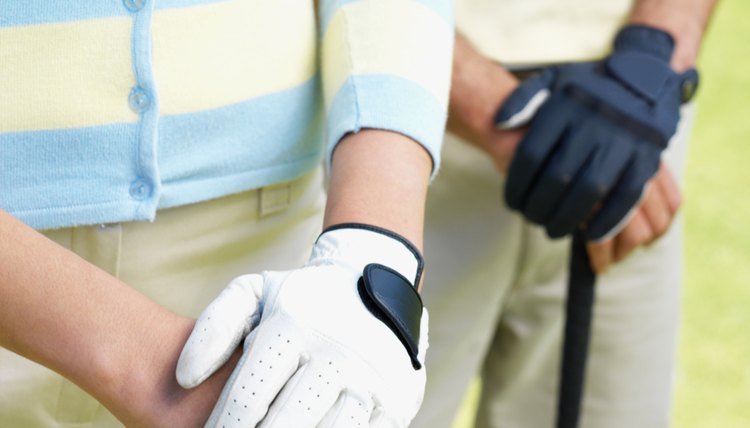The Purpose of a Golf Glove

Golf gloves are not required but are recommended for golfers of all levels. A glove is usually worn on the "lead" hand -- the hand at the top of the grip. Right-handed players most often wear a glove on the left hand, and left-handed players most often wear a glove on the right hand. While most golfers wear gloves, some choose to remove their gloves for short-iron shots and putts so that they may better "feel" the clubface when it is striking the ball.
Overview
Golf gloves are not required but are recommended for golfers of all levels. A glove is usually worn on the "lead" hand -- the hand at the top of the grip. Right-handed players most often wear a glove on the left hand, and left-handed players most often wear a glove on the right hand. While most golfers wear gloves, some choose to remove their gloves for short-iron shots and putts so that they may better "feel" the clubface when it is striking the ball.
Grip
The key reason to wear a golf glove is grip.
A golf glove is tackier than skin, particularly in hot weather, and will help to prevent the club from turning in a player's hand. Gloves also help create more friction between the grip and the gloved hand.
Golfers with loose grips may find gloves particularly useful. As weather can play a part in the game, specialty gloves may be used in unique situations (i.e. rain, cold weather) to improve the grip.
Blister and callous prevention
If a golf club is gripped too tightly -- the repeated swing action might result in blisters or callouses. Though wearing a glove is not a solution, it can reduce the chances of blisters and callouses forming. In addition, some golfers will tape areas of their hands that are prone to blisters.
Warmth and dryness
Golf gloves are made of many different materials and have different uses. Most golfers choose either leather or synthetic gloves that may be worn when using any club in a variety of conditions. However, some companies also manufacture weather-specific gloves, including those for cold or wet weather.
Both types of gloves are sold in pairs and it is recommended that you wear gloves on both hands in inclement or cold weather. Winter gloves are designed to keep you hands warm and dry, which will help prevent stiffness and allow you to maintain a natural grip. Rain gloves help resist moisture, allowing you to grip the club well even in wet weather.
Writer Bio
J.D. Chi is a professional journalist who has covered sports for more than 20 years at newspapers all over the United States. She has covered major golf tournaments and the NFL as well as travel and health topics. Chi received her Bachelor of Arts in professional writing from Carnegie Mellon University and is working toward a master's degree in journalism.
